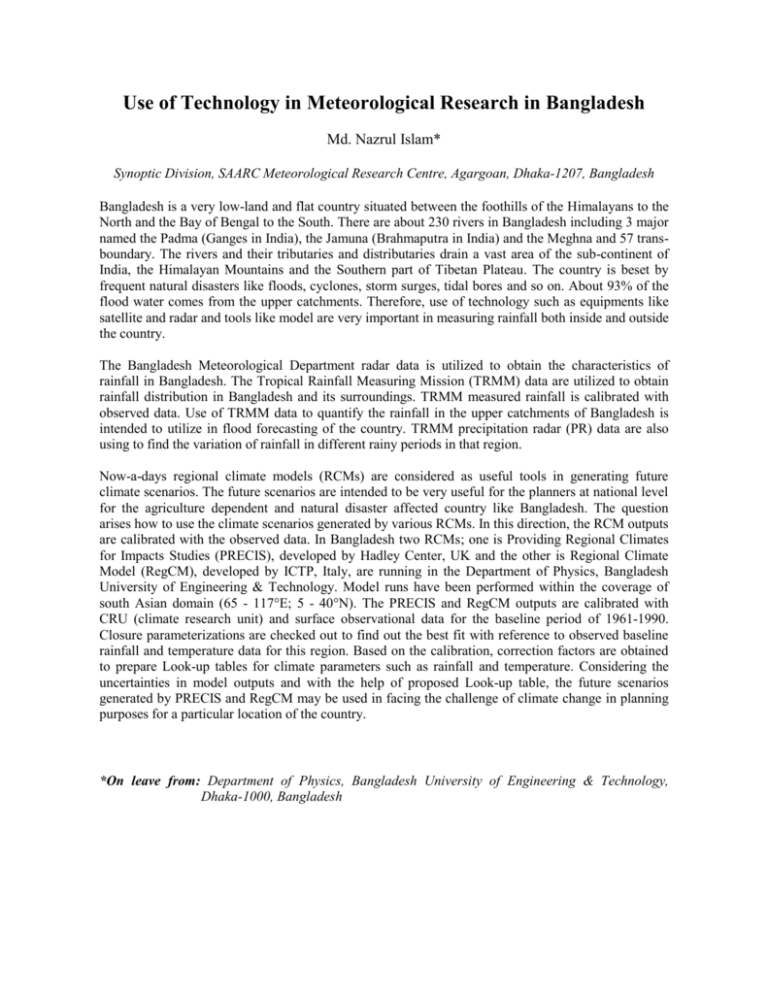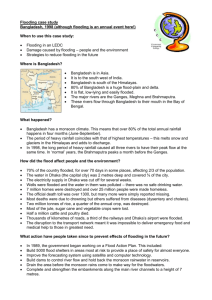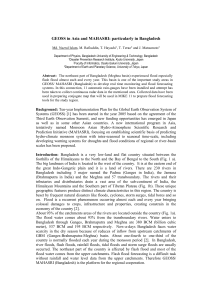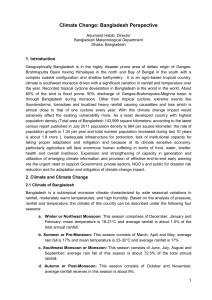Remote Sensing and Climate Model data in Meteorological
advertisement

Use of Technology in Meteorological Research in Bangladesh Md. Nazrul Islam* Synoptic Division, SAARC Meteorological Research Centre, Agargoan, Dhaka-1207, Bangladesh Bangladesh is a very low-land and flat country situated between the foothills of the Himalayans to the North and the Bay of Bengal to the South. There are about 230 rivers in Bangladesh including 3 major named the Padma (Ganges in India), the Jamuna (Brahmaputra in India) and the Meghna and 57 transboundary. The rivers and their tributaries and distributaries drain a vast area of the sub-continent of India, the Himalayan Mountains and the Southern part of Tibetan Plateau. The country is beset by frequent natural disasters like floods, cyclones, storm surges, tidal bores and so on. About 93% of the flood water comes from the upper catchments. Therefore, use of technology such as equipments like satellite and radar and tools like model are very important in measuring rainfall both inside and outside the country. The Bangladesh Meteorological Department radar data is utilized to obtain the characteristics of rainfall in Bangladesh. The Tropical Rainfall Measuring Mission (TRMM) data are utilized to obtain rainfall distribution in Bangladesh and its surroundings. TRMM measured rainfall is calibrated with observed data. Use of TRMM data to quantify the rainfall in the upper catchments of Bangladesh is intended to utilize in flood forecasting of the country. TRMM precipitation radar (PR) data are also using to find the variation of rainfall in different rainy periods in that region. Now-a-days regional climate models (RCMs) are considered as useful tools in generating future climate scenarios. The future scenarios are intended to be very useful for the planners at national level for the agriculture dependent and natural disaster affected country like Bangladesh. The question arises how to use the climate scenarios generated by various RCMs. In this direction, the RCM outputs are calibrated with the observed data. In Bangladesh two RCMs; one is Providing Regional Climates for Impacts Studies (PRECIS), developed by Hadley Center, UK and the other is Regional Climate Model (RegCM), developed by ICTP, Italy, are running in the Department of Physics, Bangladesh University of Engineering & Technology. Model runs have been performed within the coverage of south Asian domain (65 - 117°E; 5 - 40°N). The PRECIS and RegCM outputs are calibrated with CRU (climate research unit) and surface observational data for the baseline period of 1961-1990. Closure parameterizations are checked out to find out the best fit with reference to observed baseline rainfall and temperature data for this region. Based on the calibration, correction factors are obtained to prepare Look-up tables for climate parameters such as rainfall and temperature. Considering the uncertainties in model outputs and with the help of proposed Look-up table, the future scenarios generated by PRECIS and RegCM may be used in facing the challenge of climate change in planning purposes for a particular location of the country. *On leave from: Department of Physics, Bangladesh University of Engineering & Technology, Dhaka-1000, Bangladesh








